When the Beanie Baby craze took over in the ’90s, many of us bought in and hoped we’d end up with the most valuable Beanie Babies. Decades later, you might be wondering if your plastic bins in storage hold a lottery ticket to the big riches your 1990s heart craved.
Hate to be the bearer of bad news, but your Beanie Babies are probably not worth as much as you think. Some misinformation has made the rounds online, alleging that certain Beanies (I’m looking at you, Princess Diana the Bear), are worth much, much more than they really are — I’m talking the price of two or three brand new cars.
Most Beanies aren’t even worth a hundred bucks, and to make matters more confusing, it’s very difficult to figure out the actual worth of a Beanie Baby. I’m going to take a stab at it here, and I’m also providing a primer on what makes a most valuable Beanie Baby and how to determine if you have one in your hot little hands.
And speaking of pretty pennies, if you like saving them in addition to earning them, take a sec to get the free Krazy Coupon Lady app.
Ronald McDonald's House International Beanie Babies set of four may be worth some money.
The rare set of four Ronald McDonald's House International Beanie Babies, including Maple the Bear (Canada), Erin the Bear (Ireland), Glory the Bear (U.S.A.), and Britannia (the U.K.) may be worth some money — anywhere from about $10 each up to thousands of dollars for the set.
Here's everything you need to know about how to find out what your Beanie Babies are worth.
What is my Beanie Baby worth?
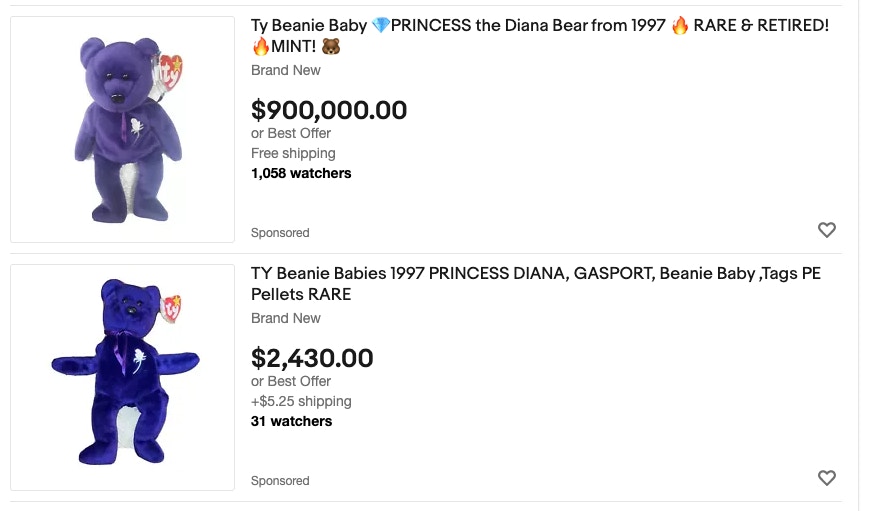
No, no she’s not. I’ll show you why.
It’s tempting to go straight to eBay and search to see if you have one of the most valuable Beanie Babies. Unfortunately, that won’t do much besides set you up for disappointment because prices are very exaggerated.
So, how do you determine the value of your character? You have to find out how much people are actually paying for it, not what people are asking for it. We all learned as children that it never hurts to ask, but that doesn’t mean you’ll receive. This applies here. eBay sellers can ask, but it doesn’t mean they’re selling for that price, and it definitely doesn’t mean that’s what a Beanie is worth.
I’ll show you how to find out what prices people are actually paying for the most valuable Beanie Babies.
Check recently sold and completed items on eBay first.

Let’s stick with Princess Diana as an example. According to Beaniepedia, the first step toward assessing the value of your character is to enter their name on eBay. Along the left-hand side of the screen, find checkmarks for “Completed” and “Sold” items. Select those both. This will show you a history of recent sales for your character.
You can see here that the prices are significantly lower for Princess Diana once we rule out all the “wishful-thinking” listings. But we’re not done yet.
Next, sort by lowest price first. (Spoiler alert: It’s probably $0.99.)

That said, every character has a range of sold listings and so you may be able to get a bit more than $0.99, depending on its condition. Still, I’m talking a few more dollars, not more Ben Franklins.
This approach will help you sort through the overinflated Beanie Baby prices.
Look for the “Top Rated Plus” symbol next to a listing.

If you’re trying to push into the higher prices to determine the top of the range for most valuable Beanie Babies instead of just accepting the very lowest price you find, look for the “Top Rated Plus” symbol. This means a seller is reliable, has been around a decent amount of time, has favorable reviews or otherwise is more trustworthy in general. If it’s sold by this sort of seller, it’s probably safe to say it’s a true price someone paid.
Why are Beanie Baby prices so overinflated?
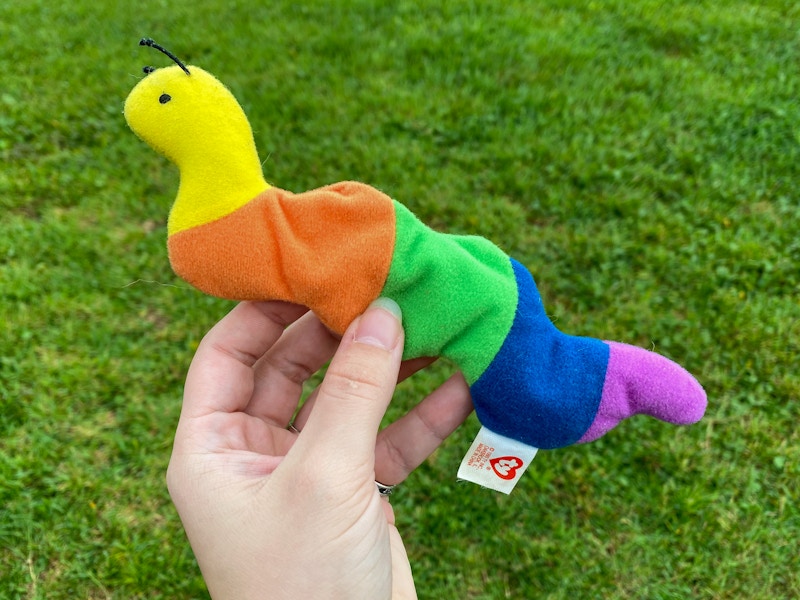
Courtesy of Lucis Poppenger
Thanks to eBay’s structure and a seller’s desire to earn money from Beanie Babies, eBay has become a cesspool of problems for Beanie collectors.
While you can try very hard to suss out the true value of your Beanie Baby, you still may not succeed to perfection. For example, you may still find accounts that seem legitimate selling Beanie Babies for thousands of dollars. Even though you know it can’t be right. Some “Sold” listings are perplexing.
Beanie Baby experts told Vice.com that they believe it may be due to money laundering. That people could be listing these plushies on eBay for thousands and thousands of dollars, and then an accomplice may be buying them up. There’s no way to know for sure if this is happening, but it’s one explanation, and another proof that you can’t trust those high listing prices on eBay.
Questions to help you find red flags when it comes to the most valuable Beanie Babies:
Does the seller seem legitimate? Some red flags are a seller with a newly created account and no sales history.
Was the item listed, the listing removed, and then it was re-listed for a lower price? This is another sign of something fishy.
Is there a line through the listing? A strikethrough means the price listed isn’t actually what the seller received, but instead the price was negotiated, and is private information between buyer and seller. You can’t take these listed prices for face value.
What do the most valuable Beanie Babies have in common?

Now that we’ve gotten through those disclaimers and warnings, let’s talk about what collectors look for because there’s going to be a range of value based on condition and other factors.
The first generation introduced in 1993 are the most valuable Beanie Babies (and hardest to find). The “Original Nine” are:
Splash the Killer Whale
Flash the Dolphin
Squealer the Pig
Pinchers the Lobster
Spot the Dog
Legs the Frog
Chocolate the Moose
Brownie the Bear
Patti the Platypus
Note: Just because you have one of the Original Nine, doesn’t mean you’re sitting on a gold mine. (Because there really are no gold mines in the Beanie Baby game, which I hope you’re starting to pick up on.) But it’s a good start.
Do you have one of the most valuable Beanie Babies?

In addition to its rarity (whether it’s a first, second, or third generation character), condition, tags, and stuffing will also help you figure out the worth of your Beanie. A mint condition Beanie should pull a higher price than one with a missing tag, for example.
Condition
Mint: No signs of wear or tear and the hang tag is in perfect condition.
Near Mint: No signs of wear or tear on the character, but maybe the tag is slightly worn. Sells for roughly 10 – 20% less than what a mint condition character can fetch.
Excellent: The tag may show wear, but the character is in perfect condition. You can expect to get up to 25% less than what a mint condition character is worth.
Very Good: The tag can be quite worn, or even missing, as long as the character is still in perfect condition. Expect to get up to 60% less than a mint character.
Damaged: Or better stated, “played with and well-loved.” The character might be worn, tags missing, or repairs may be needed. Expect to get up to 95% less than what a mint character gets.
Tags
Beanie Babies have two tags. The swing tag, or the little paper heart with the “Ty” logo, and the tush tag, or the silky loop on the character’s rear end.
Swing Tags: Use this Beanie Baby tag guide to help determine your character’s age and generation. If your Beanie Baby doesn’t have a tag at all, it’s worthless. Although, I can’t help but feel happy for these Beanies, as it likely means they were well loved while their brothers and sisters were put into hard plastic cases for decades. Still, no tag, no dice. If yours does have a tag, look for errors in spelling or misprints. Sometimes these can increase the character’s value. Sometimes not.
Tush Tags: Misspellings, sometimes an incorrect character’s name printed on it, or even double tags can all mean good news if you’re looking to cash your Beanie Baby in.
Stuffing
Look on the tush tag to find out if your character has PVC pellets or PE pellets. The most valuable Beanie Babies tend to have PVC pellets because that’s what Ty used prior to 1998. After that point, they switched to PE pellets because they were considered more friendly to the environment.
Errors
A quick word about character errors. This is another touchy topic as errors don’t increase the value of your Beanie Baby if they were mass produced. Meaning, some misprints were so common that it would be rare to find a certain character without errors. So, if your Beanie Baby does have an error, research whether it’s a valuable error or not. And don’t get your hopes up.
51 Most Valuable Beanie Babies
None of the prices below are guaranteed; they’re just examples I found of what people have paid for these characters on eBay based on recent sales, sorted by “Sold” and “Completed,” and then sorted by lowest price.
I found these prices by looking through individual eBay seller accounts to determine to the best of my knowledge, where the legitimate listings topped out in price.
Assume $0.99 for a true price, and what’s listed here for an example of a higher (but seemingly still legitimate) recent sale price. Basically, it’s a price you might be able to hope for, based on the condition of your character.
Check out these thrift store shopping hacks to up your thrifting game.
1. Princess Diana Bear: $65

Ty made Princess to commemorate the tragic death of Princess Diana of Wales in 1997. People bought these up, believing they’d be a limited edition, only to find that Ty mass produced them once they saw the bear’s popularity.
2. Pinchers the Lobster: $50
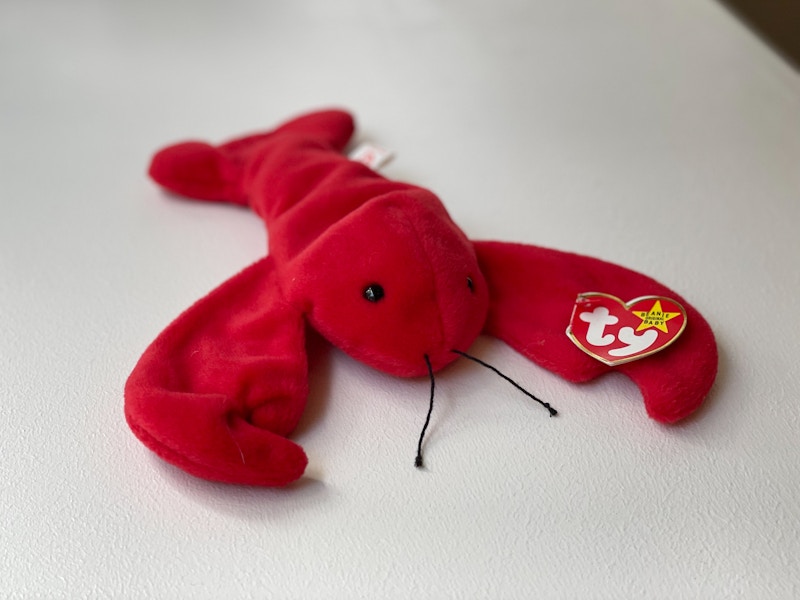
Pinchers was introduced in 1993 and retired in 1998.
3. Chocolate the Moose: $49.99
Chocolate was one of the Original Nine, introduced in 1994 and retired in 1998.
4. Patti the Platypus: $45

Patti was introduced in 1993 (one of the Original Nine) retired in 1998. She came in four colors: Deep Fuchsia, Raspberry, Magenta, and Fuchsia.
5. Curly the Bear: $39.99
Introduced in 1996 and retired in 1998, Curly is often seen with a “Peace,” “Blackie,” or “Teddy” tush tag.
6. Spangle the Bear: $29
There were three versions of Spangle. One with a white face, one with a blue face, and one with a pink face. The pink face Spangle bear was only available for five months in 1999.
7. Hippity, Hoppity, and Floppity: $28.99
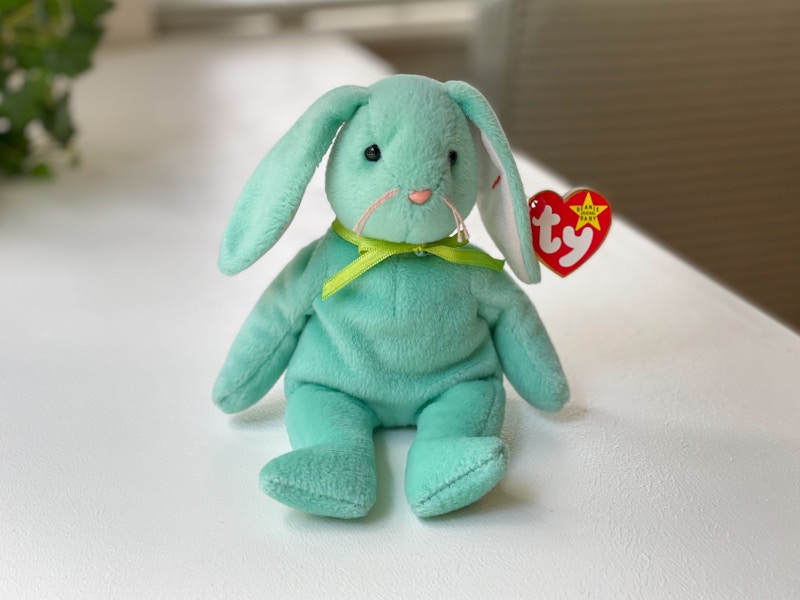
These three bunnies were released in 1996 during the lead-up to Easter. Hippity, Hoppity, and Floppity came in a couple versions. The most valuable are pale pink, green, and lavender in color (the other, later versions are white or bright pink). If you have the set, you’re lucky!
8. Hope Bear: $19.99
Hope was released in 1998 and retired in 1999. If you find one with a hologram tush tag, you might be able to get a bit more for it.
9. Ringo the Raccoon: $19.99
Ringo was released in 1996 and retired in 1998.
10. Jake the Duck: $18.49
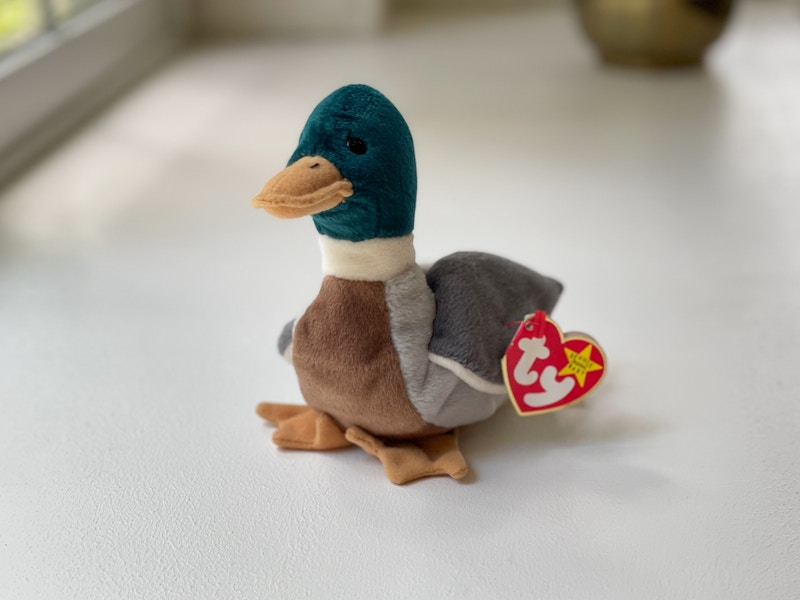
Jake isn’t supposed to be on this list of most valuable Beanie Babies. According to Beaniepedia, he’s common and any tag errors are also common. Yet, he’s selling for more than some other Beanies. He was introduced in 1998 and retired in 1999.
11. Piccadilly the Bear: $17.99
Ty released Piccadilly in two versions, one with the green and blue costume, and another with a rainbow costume. He was introduced in 1998 and retired in 2000.
12. Halo the Bear: $16.90
Halo was introduced in 1998 and retired in 1999. You’ll notice on eBay, Halo is often listed with a “rare” brown nose. This is not rare; Halo comes with a brown nose.
13. Snip the Cat: $16.90
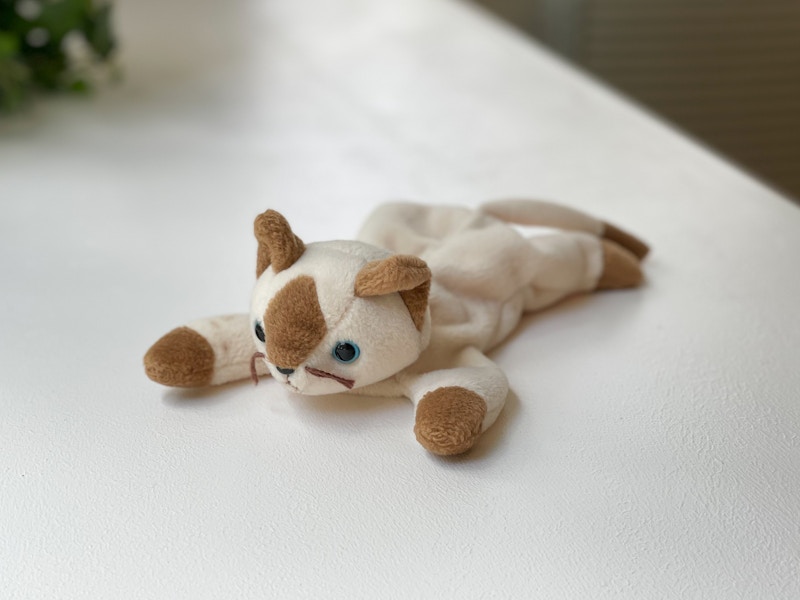
Snip was released in 1997 and retired in 1998.
14. Bubbles the Fish: $14.95

Bubbles was introduced in 1995 and retired in 1997.
15. Iggy the Iguana: $14.49
Iggy was released in 1998 and retired in 1999. Due to confusion during his release, some blue Iggys have a tag that incorrectly says “Rainbow.” This is one of those errors that’s so common that it doesn’t increase the value of a character with it. In total, there are three Iggys. A blue one without a tongue sticking out, a tie-dyed one with a tongue sticking out, and a pastel one with a tongue. The colored Iggys seem to fetch a higher price.
16. Brownie the Bear: $14.25
Brownie is one of the Original Nine introduced in 1993. Ty changed his name to “Cubbie” and retired him later that same year.
17. Millennium Bear: $13.99
Millennium Bears were introduced in January 1999 and retired in November 1999. Millennium is often listed with a tag error (“Millennium” misspelled as “Millenium” among others), but it’s uncertain how much that actually adds to his value.
18. 1999 Signature Bear: $12.99
The 1999 Signature Bear was Ty’s first release of this series. After that, each year saw a new Signature Bear.
19. Rocket the Blue Jay: $12.90
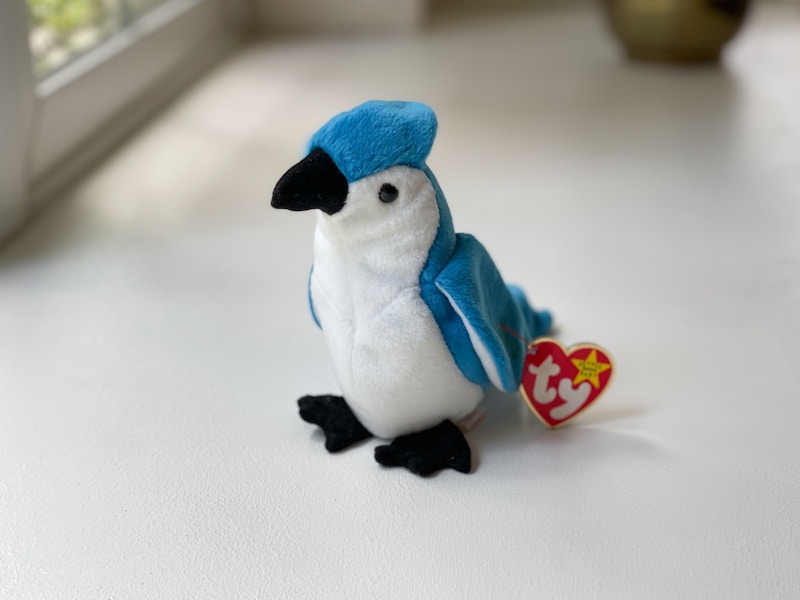
Released in 1998 and retired just a year later.
20. Gobbles the Turkey: $12.90
Gobbles was introduced in 1997 and retired in 1999.
21. Snort the Bull: $11.99
Released in 1997 and retired in 1998, Snort received a name change from “Tabasco” when Ty ran into copyright issues with the name. The only difference between Snort and Tabasco is that Snort has cream-colored hooves and Tabasco didn’t. They have the same style number and birthday.
22. Libearty the Bear: $11.99
Libearty was originally released in 1996 to coincide with the Summer Olympics. Originally, it had the word, “Olympics” printed on it, but Ty had to remove it due to copyright.
23. Claude the Crab: $11.90
If you have a Claude with a “R” symbol above the ™ symbol on its tush tag, yours may be worth something. Claude was introduced in 1997 and retired in 1998. A year later, he was given out to all-season ticket holders at a March Sacramento Kings versus L.A. Lakers game.
24. Peking Panda: $11.66
Peking was the first panda Ty made and was released in 1994, retired in 1996.
25. Digger the Crab: $11.49
The most valuable Digger is orange in color. The red version was introduced in 1995 and retired in 1997 and won’t get you quite as much.
26. Pouch the Kangaroo: $10.90

Pouch is a mother-joey duo that was introduced in 1997 and retired in 1999.
27. Peace the Bear: $10.90
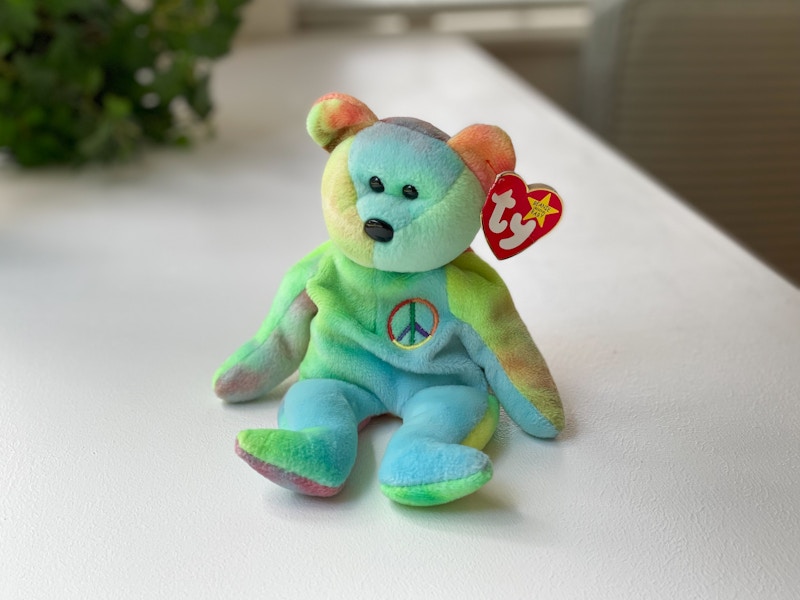
Peace was released in 1997 and retired in 1999. No two Peace bears have the same “tie-dye” pattern, so whether this is one of the most valuable Beanie Babies will depend a bit on if a particular collector likes the pattern of your Peace bear.
28. Batty the Bat: $10.90
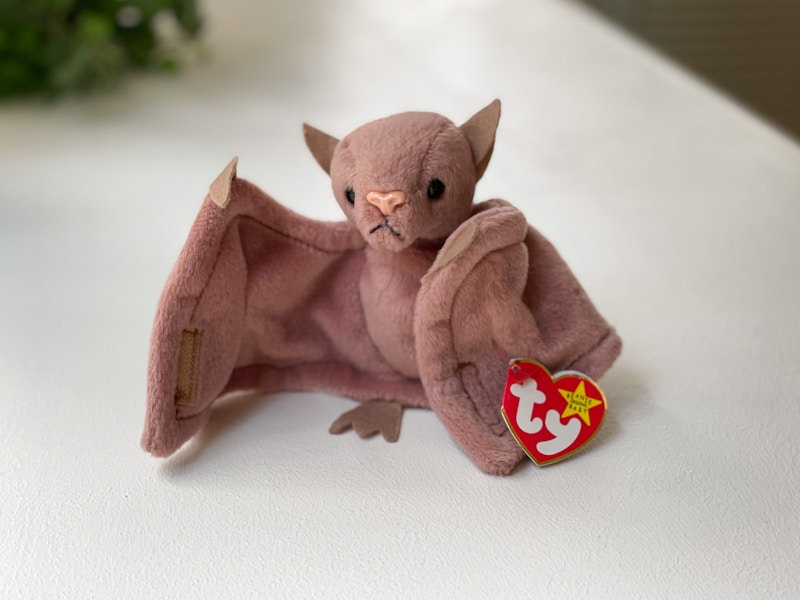
Batty the Bat was introduced in 2000 and retired in 2001. Batty was made in a brown, black, and a tie-dyed version.
29. Jabber the Parrot: $10
Jabber was released in 1998 and retired in 1999.
30. Steg the Stegosaurus: $9.99
Released in 1995 and retired in 1996, a true Steg will have the year “1995” printed on the tag. Also, Steg’s fabric is always green, brown, and yellow. He’s frequently a victim of counterfeiting, so heads up.
31. Seaweed the Otter: $9.90
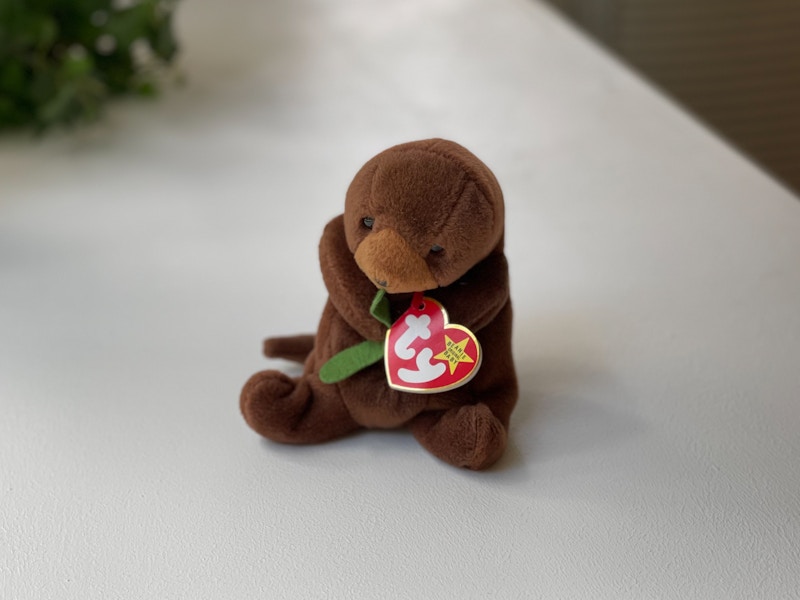
Seaweed was introduced in 1996 and retired in 1998.
32. Spike the Rhinoceros: $8.99
Spike was introduced in 1996 and retired in 1998.
33. Tuffy the Terrier: $8.99

Tuffy was released in 1997 and retired in 1998. He has been seen with a “twisted nose” error that may or may not increase his value.
34. Maple the Bear: $8.97
If your Maple has the name “Pride” on its swing tag, you may have one of the most valuable Beanie Babies. Maple was going to be named “Pride,” but while the name was changed before its release, some of the tags were not. You can only find these with a fourth-generation swing tag.
35. Valentino the Bear: $8.90
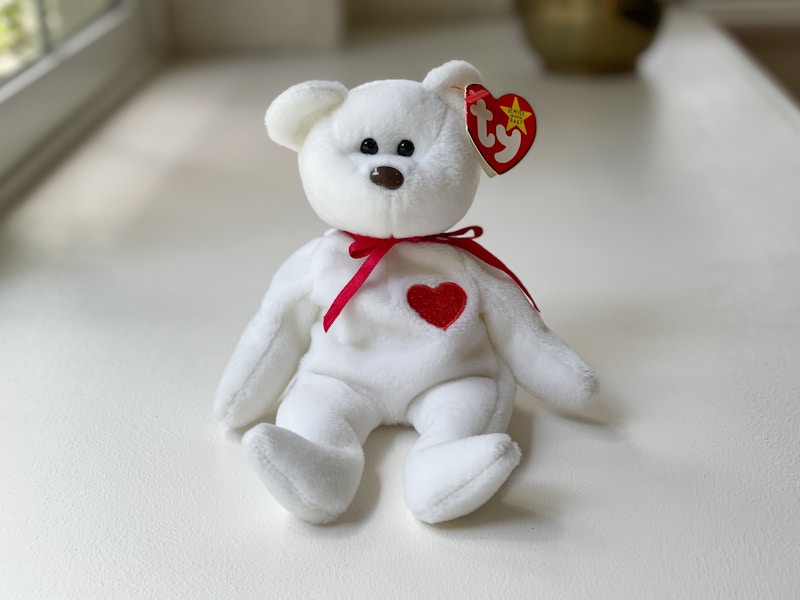
Don’t be duped into believing your Valentino is worth more than he actually is. For example, a brown nose is not an error for Valentino, even though a lot of false information says it is. Valentino was introduced in 1995 and retired in 1998.
36. Bongo the Monkey: $8.90
Bongo was introduced in 1995 but originally introduced as “Nana.” The price here is what I found for Bongo, because I couldn’t even find a recently sold Nana on eBay. If you find one, it may be worth more.
37. Freckles the Spotted Leopard: $7.50
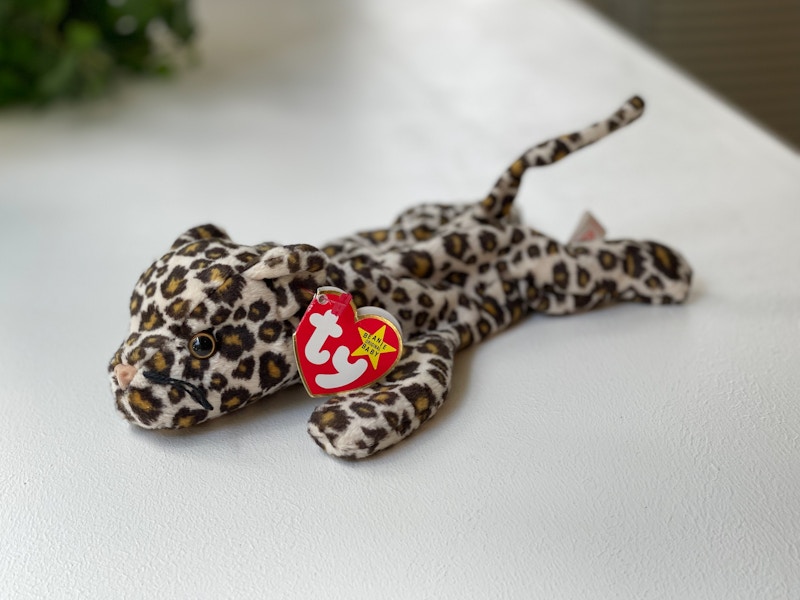
Freckles was only available for one month, during a McDonalds promotion that ran from May – June in 1999.
38. Inch the Inchworm: $6.99
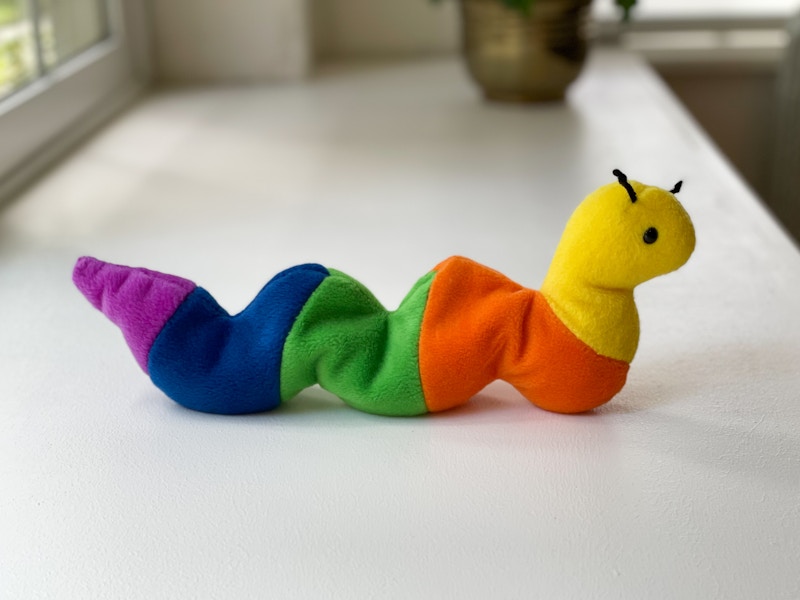
Inch was released in 1997 and retired in 1998. There are two versions of Inch, one with a yarn antennae and one with a felt antennae. The felt is rarer and therefore more valuable.
39. Bernie The Saint Bernard Dog: $6.99

Bernie was introduced in 1997 and retired in 1998.
40. Rover the Dog: $6.97
Rover was introduced in 1996 and retired in 1998.
41. The End Bear: $6.79
The End was released in 1999 when Ty tried to retire the entire line of Beanie Babies, but after public outcry, they kept Beanie Babies in production.
42. Rainbow the Chameleon: $6.50
There’s a blue version of Rainbow and a multicolored version. The multicolored version came out a month before the blue version, so it may be more valuable. Both versions came out in 1998 and retired in 1999.
43. Nuts the Squirrel: $6.50
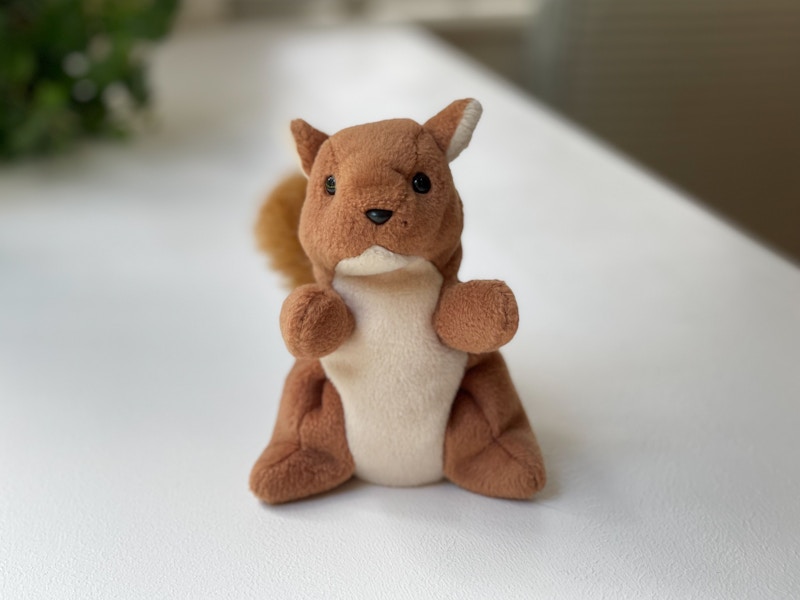
Nuts was released in 1997 and retired in 1999 and can be found with an extra whisker, adding to his value.
44. Twigs the Giraffe: $6
Twigs was released in 1996 and retired in 1998.
45. Wallace the Bear: $5.90
Wallace Bear was retired just four months after his introduction in 1999.
46. Blackie the Black Bear: $5.50
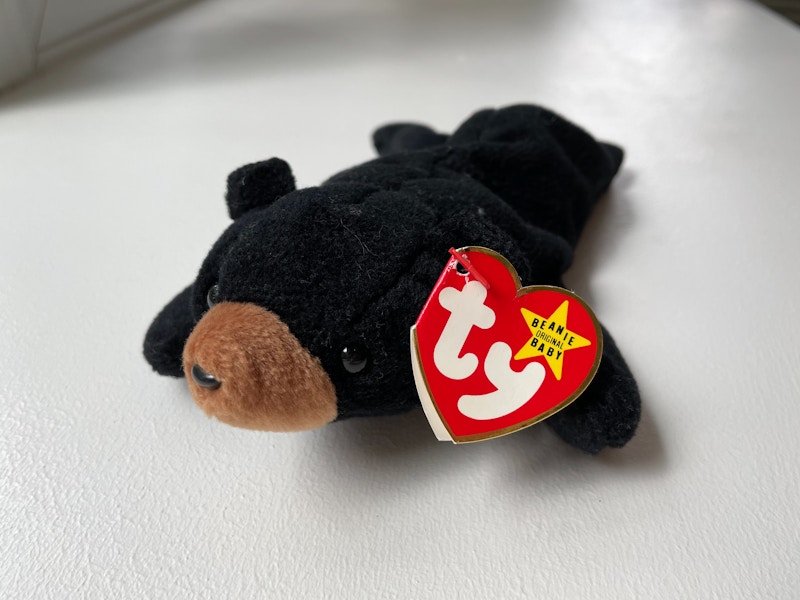
Blackie was introduced in 1994 and retired in 1998.
47. Scoop the Pelican: $4.99
Scoop was introduced in 1996 and retired in 1998 and has been known to carry an error where the tush tag says a different character’s name. Your mileage may vary with this error adding to his value.
48. Doodle the Rooster: $4.79
Doodle’s name was changed to “Strut” just three months after his release because Chik-fil-A’s mascot was named “Doodle.” So Doodle may be worth more, as he was only in production for a few months.
49. Jolly the Walrus: $3.90
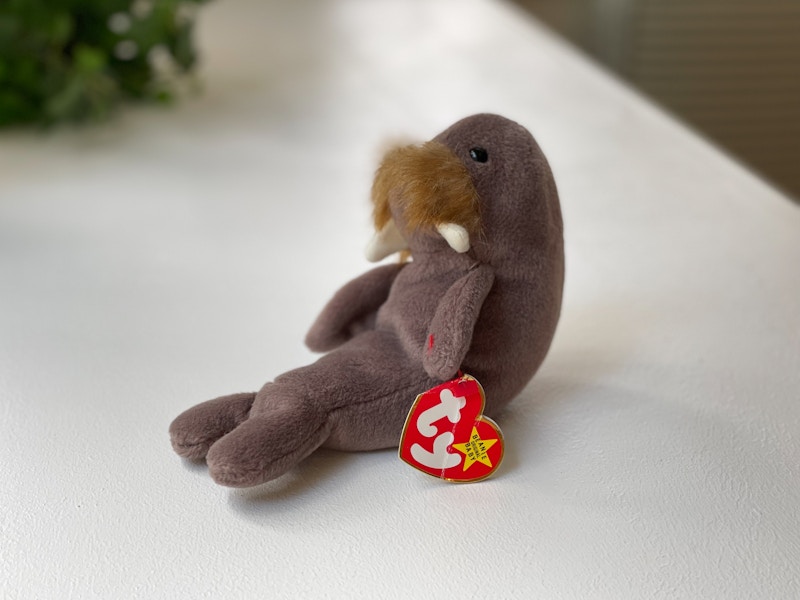
Jolly was introduced in 1997 and retired in 1998.
50. Wise the Owl: $2.99
Wise is a graduation owl, and he wears a hat that says “Class of ’98.” He was introduced in 1997 and retired in 1998.
51. Kuku the Cockatoo: $1.99
Kuku was released in 1998 and retired in 1999.












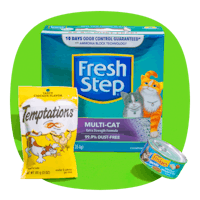

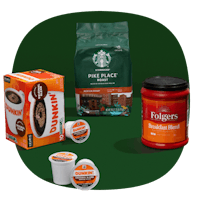
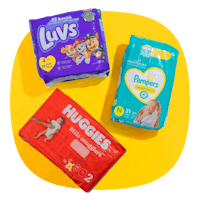




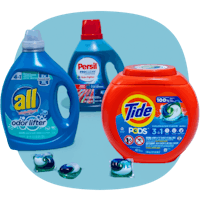











Tell us what you think